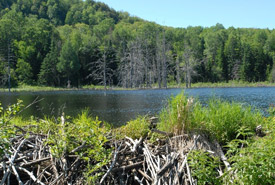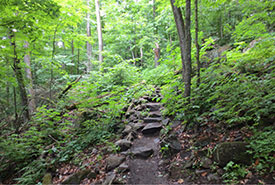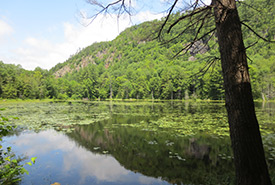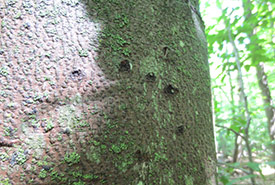A day in the field at the Alfred-Kelly Nature Reserve

Alfred-Kelly Nature Reserve, QC (Photo by NCC)
When I started my communications internship here at the Nature Conservancy of Canada (NCC) back in May, I didn’t think I would get the opportunity to visit an NCC property this summer. Luckily, I was wrong.
After a bit of planning, I joined Arigna Luangphachaleun, one of NCC's stewardship interns in the Quebec Region, for a routine day in the field at one of our properties. That day, I came home not only with rosy cheeks and a few mosquito bites too many, but also with a better understanding of what conservation actually means. Most of all, I got a much-needed break from the buzz of city life and a renewed appreciation for nature.
We visited the Alfred-Kelly Nature Reserve, a property straddling the municipalities of Piedmont, Prévost and Saint-Hippolyte, in the Laurentians. Located just shy of an hour outside of downtown Montreal, the reserve is a haven for wildlife and a beautiful hiking site for visitors. It is also one of NCC’s Nature Destinations in Quebec; one that’s definitely worth a visit!
Related blog posts

Some stairs built by NCC interns last summer on the property’s main hiking trail (Photo by NCC)
Our first goal for the day was to walk most of the hiking trails and be on the lookout for anything unusual, like trash, fallen trail signs or broken footbridges. We packed our bags with plenty of water, some snacks, a map and a bottle of insect repellent, and then we were on our way. Using a smart tablet linked to a GPS tracker, we were able to take down information along with a precise location. We reported a few obstructed trails, some broken trees and an odd pipe, but nothing out of the ordinary.
The trails at Alfred-Kelly meander through dense forests, as well as eastern hemlock and yellow birch maple groves. Here you can find large mammals, such as white-tailed deer and black bear, but rest assured, bear sightings rarely occur! Smaller creatures, including eastern chipmunk and porcupine, also roam the forest.

Lac Paradis and its nearby cliffs, where eagles nest (Photo by NCC)
After close to two hours of hiking and searching for these species, we took a well-deserved break at the reserve’s artificial lake, Lac Paradis. Located near an old pine forest, it shelters numerous species of waterfowl, amphibians and fish, as well as painted turtle. This is a great spot to rest and enjoy the peaceful surroundings, although you’ll definitely hear bullfrogs croaking around the lake. If it’s your lucky day, you might also notice bald eagles flying from nearby cliffs.
Next on our list was finding appropriate spots to install various signs that will eventually lead visitors along a self-guided tour. Interesting sightings included bear claw marks on a particularly tree, American beech, and woodpecker nests scattered around dead trees. These are things you won’t want to miss if you happen to visit the region.

Bear claw marks (Photo by NCC)
Conservation is about safeguarding and sometimes creating habitats to protect Canada’s rich biodiversity. When you’re on the ground, this means everything from in-depth monitoring of species and their whereabouts, to coming up with captivating ways to raise awareness of conservation priorities and keep the public informed. If my day in the field has taught me anything, it’s that conservation is a fascinating process. It also conserves gorgeous patches of nature that are worth enjoying.
Head out there and see for yourself! Visit the Alfred-Kelly Nature Reserve Nature Destination web page for more information!
The Conservation Internship Program is funded in part by the Government of Canada's Summer Work Experience program.


